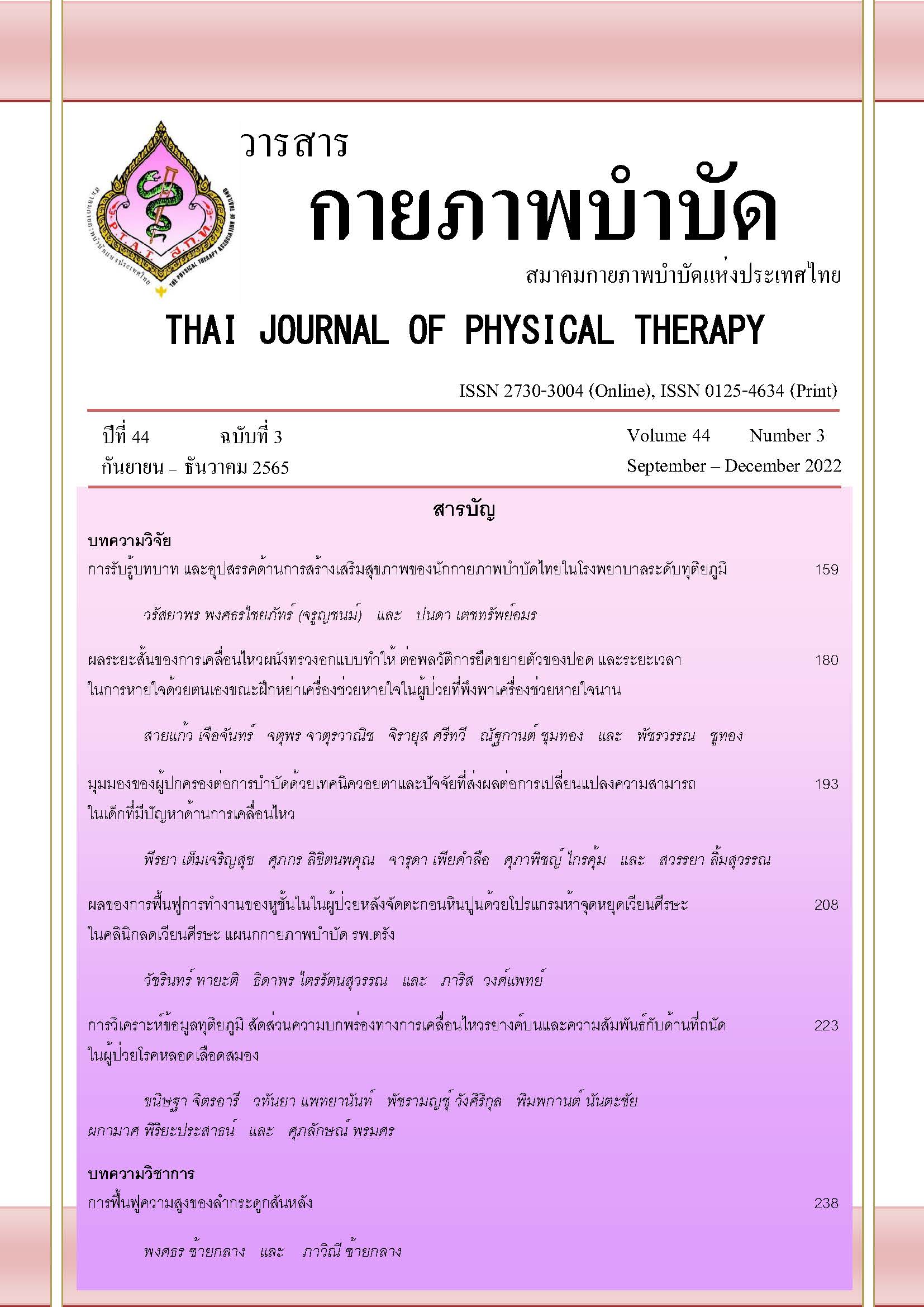ผลระยะสั้นของการเคลื่อนไหวผนังทรวงอกแบบทำให้ ต่อพลวัติการยืดขยายตัวของปอด และระยะเวลาในการหายใจด้วยตนเองขณะฝึกหย่าเครื่องช่วยหายใจใน ผู้ป่วยที่พึงพาเครื่องช่วยหายใจนาน
Main Article Content
บทคัดย่อ
ที่มาและความสำคัญ: การเคลื่อนไหวผนังทรวงอกแบบทำให้ ส่งผลต่อการเปลี่ยนแปลงความยาวกล้ามเนื้อผนังทรวงอก และอาจทำให้ความสามารถในการยืดขยายตัวของปอด เพิ่มขึ้นในผู้ป่วยที่พึ่งพาเครื่องช่วยหายใจเป็นเวลานานได้
วัตถุประสงค์: เพื่อประเมินผลของการเคลื่อนไหวทรวงอกแบบทำให้ต่อพลวัติการยืดขยายตัวของปอด และระยะเวลาที่ผู้ป่วยหายใจด้วยตนเองขณะฝึกหย่าเครื่องช่วยหายใจในผู้ป่วยที่ใส่เครื่องช่วยหายใจ
วิธีการวิจัย: ผู้ป่วยที่ใส่เครื่องช่วยหายใจนาน 20 ราย ถูกสุ่มเป็น 2 กลุ่ม กลุ่มทดลองจำนวน 10 ราย (อายุเฉลี่ย 62.90 ± 29.43 ปี) ได้รับการฝึกการเคลื่อนไหวทรวงอกแบบทำให้ 30 ครั้งต่อชุด 3 ชุดต่อวัน ต่อเนื่องเป็นเวลา 5 วัน ร่วมกับเทคนิคทางกายภาพบำบัดทรวงอกปกติ (การฝึกหายใจเข้าลึก เคาะปอด สั่นปอด จัดท่าระบายเสมหะ และดูดเสมหะ) กลุ่มควบคุมจำนวน 10 ราย (อายุเฉลี่ย65.30 ± 21.33 ปี) ได้รับเฉพาะการรักษาทางกายภาพบำบัดทรวงอกปกติ เปรียบเทียบความแตกต่างของค่าพลวัติการยืดขยายตัวของปอด (dynamic lung compliance: Cdyn) ระยะเวลาการหายใจด้วยตนเองก่อน และหลังการฝึกภายในกลุ่ม และระหว่างกลุ่ม
ผลการวิจัย: หลังจากฝึกเป็นเวลา 5 วัน กลุ่มทดลองมีการเพิ่มขึ้นอย่างมีนัยสำคัญทางสถิติของค่าเฉลี่ยของพลวัติการยืดขยายของปอดจาก 26.29 ±11.29 มิลลิลิตร/เซนติเมตรน้ำ เป็น 35.07± 13.09 มิลลิลิตร/เซนติเมตรน้ำ (p<0.05) ส่วนกลุ่มควบคุมเพิ่มขึ้นเล็กน้อย แต่ไม่พบความแตกต่างทางสถิติเมื่อเปรียบเทียบระหว่างกลุ่ม ค่าเฉลี่ยของระยะเวลาการหายใจด้วยตนเองขณะฝึกหย่าเครื่องช่วยหายใจเพิ่มขึ้นอย่างมีนัยสำคัญทางสถิติจาก 6.41 ± 7.6 ชั่วโมง เป็น 16.18 ± 9.11 ชั่วโมง ส่วนกลุ่มควบคุมมีค่าลดลงเล็กน้อย เมื่อเปรียบเทียบระหว่างกลุ่มพบความแตกต่างอย่างมีนัยสำคัญทางสถิติ (p<0.05)
สรุปผล: การเคลื่อนไหวทรวงอกแบบทำให้ในผู้ป่วยที่ใช้เครื่องช่วยหายใจนานร่วมกับการรักษาทางกายภาพบำบัดปกติ สามารถเพิ่มพลวัติการขยายตัวของปอด และระยะเวลาในการหายใจเองขณะหย่าเครื่องช่วยหายใจ การศึกษาครั้งต่อไปควรศึกษาในกลุ่มประชากรที่มากขึ้น
Article Details

อนุญาตภายใต้เงื่อนไข Creative Commons Attribution-NonCommercial-NoDerivatives 4.0 International License.
เอกสารอ้างอิง
O’Connor ED, Walsham J. Should we mobilise critically ill patients? A review. Crit Care Resusc. 2009;11(4):290–300.
Garzon-Serrano J, Ryan C, Waak K, Hirschberg R, Tully S, Bittner EA, et al. Early mobilization in critically ill patients: patients’ mobilization level depends on health care provider’s profession. PMR. 2011;3(4):307–13.
Mackenzie L. Core topics in mechanical ventilation. New York: Cambridge Uiversity Press; 2008.
Gosselink R, Clerckx B, Robbeets C, Vanhullebusch T, Vanpee G, Segers J. Physiotherapy in the intensive care unit. Neth J Crit Care. 2011;15:66–75.
Denehy L, Berney S, Skinner E, Edbrooke L, Warrillow S, Hawthorne G, et al. Evaluation of Exercise Rehabilitation for Survivors of Intensive Care: Protocol for a Single Blind Randomised Controlled Trial. Open Crit Care Med J. 2008;1(1):39–47.
Yang KL, Tobin MJ. A prospective study of indexes predicting the outcome of trials of weaning from mechanical ventilation. N Engl J Med. 1991;324(21):1445–50.
Chatmongkolchart S, Wansuwanakul T, Songwanthana P. Respiratory care. Songkhla: Chanmuang press; 2007.
Agmy GR, Mohammad HA, Hassanin AAM. The prognostic value of the dead-space fraction and other physiological parameters in the weaning process of mechanical ventilation in patients with obstructive air flow. Egypt J Bronchol. 2015;9(3):245–52.
Wongsa A, Whahanadhama A, Wacharasint P. Mechanical ventilation: made incredibly easy. Bangkok: Beyond Enterprise Company Limited; 2010.
Paulus F, Binnekade JM, Vroom MB, Schultz MJ. Benefits and risks of manual hyperinflation in intubated and mechanically ventilated intensive care unit patients: a systematic review. Crit Care Lond Engl. 2012;16(4):R145.
Ambrosino N, Venturelli E, Vagheggini G, Clini E. Rehabilitation, weaning and physical therapy strategies in chronic critically ill patients. Eur Respir J. 2012;39(2):487–92.
Handelsman H. Intermittent positive pressure breathing (IPPB) therapy. Health Technol Assess Rep. 1991;(1):1–9.
Leelarungrayub D, Pothongsunun P, Yankai A, Pratanaphon S. Acute clinical benefits of chest wall-stretching exercise on expired tidal volume, dyspnea and chest expansion in a patient with chronic obstructive pulmonary disease: a single case study. J Bodyw Mov Ther. 2009;13(4):338–43.
Venturelli E, Crisafulli E, Antoni F, Trianni L, Clini E. Rehabilitation in critically ILL patients. Ann Respir Med. 2011;1–7.
Thomas AJ. Physiotherapy led early rehabilitation of the patient with critical illness. Phys Ther Rev. 2011;16(1):46–57.
Burtin C, Clerckx B, Robbeets C, Ferdinande P, Langer D, Troosters T, et al. Early exercise in critically ill patients enhances short-term functional recovery. Crit Care Med. 2009;37(9): 2499–505.
Amidei C, Sole ML. Physiological responses to passive exercise in adults receiving mechanical ventilation. Am J Crit Care. 2013; 22(4):337–48.
Freitas ERFS de, Bersi RS da S, Kuromoto MY, Slembarski S de C, Sato APA, Carvalho MQ. Effects of passive mobilization on acute hemodynamic responses in mechanically ventilated patients. Rev Bras Ter Intensiva. 2012;24(1):72–8.
Leelarungrayub D. Chest Mobilization Techniques for Improving Ventilation and Gas Exchange in Chronic Lung Disease. In: Ong K, editor. Chronic Obstructive Pulmonary Disease - Current Concepts and Practice. Croatia: InTech; 2012. p. 399–422.
Park S-J, Kim S-H, Min K-O. The immediate effects of rib cage joint mobilization and chest wall stretch on muscle tone and stiffness of respiratory muscles and chest expansion ability in patients with chronic stroke. J Phys Ther Sci. 2017;29(11):1960–3.
Carlucci A, Ceriana P, Prinianakis G, Fanfulla F, Colombo R, Nava S. Determinants of weaning success in patients with prolonged mechanical ventilation. Crit Care Lond Engl. 2009;13(3):R97.
Boles J-M, Bion J, Connors A, Herridge M, Marsh B, Melot C, et al. Weaning from mechanical ventilation. Eur Respir J. 2007; 29(5):1033–56.
Chanduykit T, Patthong W, Sirikul S. The result of assessment risk of death and outcome of TBI patients in surgery and trauma intensive care unit, Nopparat Rajathanee Hospital. RTA Med J. 2009;62(3):123–30.
Rosner B. Fundamentals of biostatistics. 5th ed. Duxbery: Thomson learning; 2000. 307 p.
Ngamjarus C, Chongsuvivatwong V. n4Studies: Sample size and power calculations for iOS. The Royal Golden Jubilee Ph.D. Program- The Thailand Research Fund&Prince of Songkla University; 2014.
Ashtankar A, Kazi A. Comparative Effect of Proprioceptive Neuromuscular Facilitation (PNF) and Chest Physiotherapy with Chest Physiotherapy alone on SP02, Heart Rate, Respiratory Rate, & Lung Compliance in Mechanically Ventilated Patient. J Pharm Sci Res. 2019;11(10):3514–8.
Chang DW. Respiratory Care Calculations. USA: Delmar Publisher Inc; 1994. 22–23 p.
Frownfelter D. Chest Physical Therapy and Pulmonary Rehabilitation. 2nd ed. Chicago: Year book medical publisher; 1987.
Vassilakopoulos T, Zakynthinos S, Roussos C. Respiratory muscles and weaning failure. Eur Respir J. 1996;9(11):2383–400.
Goldstone J. The pulmonary physician in critical care • 10: Difficult weaning. Thorax. 2002;57(11):986–91.
Ninon W. Respiratory Physiology. Songkhla: Department of Physiology, Faculty of Science, Prince of Songkla University; 1996.
Thomas DC, Kreizman IJ, Melchiorre P, Ragnarsson KT. Rehabilitation of the patient with chronic critical illness. Crit Care Clin. 2002;18(3):695–715.
Needham DM. Mobilizing patients in the intensive care unit: improving neuromuscular weakness and physical function. JAMA. 2008;300(14):1685–90.
Akeson WH, Amiel D, Abel MF, Garfin SR, Woo SL. Effects of immobilization on joints. Clin Orthop. 1987;(219):28–37.
Flowers K, Michlovitz S. Assessment and management of loss of motion in orthopedic dysfunction. Postgrad Adv Phys Ther. 1988;1–12.
McDonald JW, Sadowsky C. Spinal-cord injury. Lancet Lond Engl. 2002;359(9304):417–25.
Knaus WA, Draper EA, Wagner DP, Zimmerman JE. APACHE II: a severity of disease classification system. Crit Care Med. 1985;13(10):818–29.
Wongrostrai Y, Panpakdee O, Monkong S. Clinical Nursing Practice Guideline for Successful Weaning from Mechanical Ventilation. Ramathibodi Nurs J. 2008;14(3): 347–64.
McDonald T, Stiller K. Inspiratory muscle training is feasible and safe for patients with acute spinal cord injury. J Spinal Cord Med. 2019;42(2):220–7.


